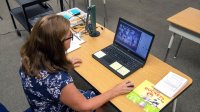How to Build a Strong Virtual Classroom Community
There is light at the end of our long tunnel of social isolation, but teachers still need to focus on students’ sense of connection to their peers and school community.
Your content has been saved!
Go to My Saved Content.It can be challenging to foster inclusive communities in the virtual environment. In addition to adapting trusted strategies for delivering instruction and learning some new ones, it’s important for teachers to make sure that their students feel safe and included. Even if a student is keeping up with their work, the pressures of learning how to navigate the virtual environment and social isolation can leave them feeling disconnected from their teachers and peers.
While synchronous experiences, either online or in person, are more conducive to community building than asynchronous ones, there are plenty of strategies that teachers can use to cultivate relationships from afar that can occur in class or outside of it.
Do-Now Decks
In much the same way that do-now activities or bell ringers provide students with something to do as soon as they enter a physical classroom, do-now decks offer stability and routine by giving them something to do as soon as they arrive in a virtual one. They can make students feel comfortable with expectations, which helps students to be more relaxed in general, and with certain prompts they encourage students to share their emotions.
Do-now decks, so-called because of their appearance as stacks of activities, are curated lists that are pinned to chat rooms and direct students to complete low-stakes activities, such as “Illustrate a vocabulary word using as many colors as possible” or “Compare your mood to the weather,” before engaging in their daily work.
These decks can contain any number of cards or prompts and can also be themed by content area. A deck for English language arts, for example, might ask students to use different types of figurative language, while a deck for mathematics might ask students to make geometric or real-world connections to what they’ve been learning in class. The example deck can be used to support learners in any subject and includes activities that address multiple intelligences as well as issues of social and emotional learning.
For novelty, students can randomize their choices for larger decks by using a random card generator; otherwise, they can simply choose an activity that appeals to them, so long as they do not choose the same task more than once during an instructional unit.
Do-now decks are effective not only because they engage students as soon as they enter the virtual classroom, but also because they give students opportunities to choose how they engage, which starts the day on a positive note by playing to their strengths.
Discussion Board Buddies
Discussion boards often provide the foundation for virtual classrooms, but rather than promoting actual discussion, discussion boards often wind up resulting in some inequity. Students who submit first typically receive the largest number of responses, as their work is the most visible, while those who post closer to the due date are often left with none.
It’s only when discussion boards start to resemble actual conversations—when students advance the conversation rather than simply comply with the bare minimum—that communities of learning and deliberation emerge.
Discussion board buddies that pair two students approximate in-person conversations because they ensure that students are engaged in a direct and meaningful back and forth. By deliberately partnering students, rather than giving them a number of students to interact with, teachers can promote the kind of inclusiveness online that generally exists in the physical environment. With discussion board buddies, each student is assured of getting responses to their ideas, and students get to know each other, as they cycle through each of the other students in the class, which can help deconstruct online groups or cliques.
It’s often easiest to assign discussion board buddies weeks in advance (perhaps through a matrix that systematically pairs students on a rotating basis) so that students know ahead of time who they are partnered with. This strategy also relieves teachers of the burden of reassigning partners for each discussion, and it allows teachers to focus on the actual content of students’ posts rather than the logistics of managing chats.
Heart Monitors
In a remote environment, it can be hard for students to connect with their teacher, just as it’s difficult for teachers to connect with their students—particularly given that many teachers and students have never met in person. It can be tough for students to express themselves and share online, particularly if they’re shy to begin with.
Heart monitors can help draw students out and build that connection. They can be short messages, such as “How are you? Is there anything I can help you with?” or “Just checking in. Send me a note, if you have the time,” that teachers can Schedule Send to students to engage with their lives inside and outside of the classroom.
In much the same way that interactive morning messages set the tone for the day and rose-and-thorn check-ins solicit input from every student, heart monitors ensure that students feel like they are a part of something bigger than themselves, even as they are receiving individualized attention and feedback. They also serve as a nice counterbalance to do-now decks and discussion board buddies.
Heart monitors are also proactive and consistent; they ensure that students receive a personalized message at regular intervals. Students do not have to reply, but doing so can deepen relationships and provide unforeseen entry points into future learning.
While these strategies are designed for the virtual environment, they can be easily adapted for in-person instruction: Do-now decks become bell ringers, discussion board buddies become discussion partners, and heart monitors become personalized notes.
